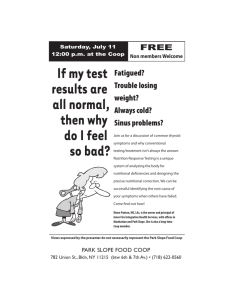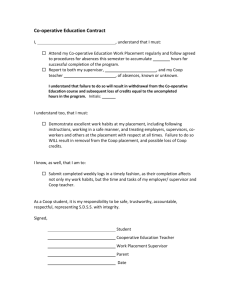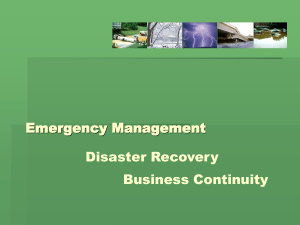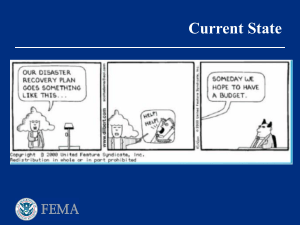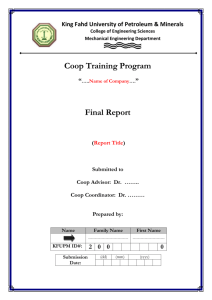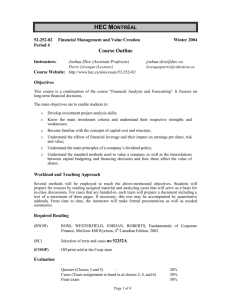Finance's Role in Continuity of Operations (COOP)
advertisement
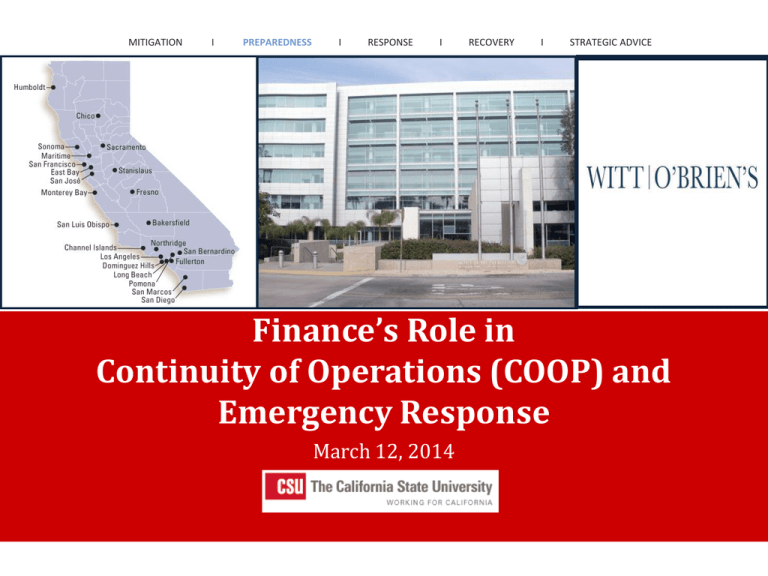
MITIGATION I PREPAREDNESS I RESPONSE I RECOVERY I STRATEGIC ADVICE Finance’s Role in Continuity of Operations (COOP) and Emergency Response March 12, 2014 Introductions • • • • Name Title University What is your role in COOP and emergency response? How do you feel about it? Presentation Overview • Disaster Priorities Exercise • Financial Vulnerability • Overview of COOP / BC • Finance in COOP/BC • Overview of Emergency Operations / Response • Finance in Emergency Response • Training and Exercises • Tying it all together Disaster Priorities Exercise • Please consider the following scenario and the 10 planning issues. • Do not attempt to develop solutions. • Come to a consensus on ranking numerically the issues in order of their importance. • Use the Problem Matrix Table. • Select a spokesperson to report out. Disaster Priorities Exercise • Scenario o March 12th, 8:30am: a 6.4 earthquakes hits the region where your campus is located. o The University has experienced extensive damage: − − − − − Finance building Building where IT servers are housed Administration building Ingress and egress routes blocked Power outages o Surrounding community has been affected o The Governor has asked for a disaster declaration by the U.S. President. PRIORITY 1 Etc. 2 3 Number ISSUE A PAYROLL WEEK B PROCUREMENT OF RESOURCES FOR EMERGENCY RESPONSE C STUDENT LOANS AND FINANCIAL AID PAYMENTS D MAINTAINING INFORMATION FOR FINANCIAL REPORTING E SEND A REPRESENTATIVE TO THE EMERGENCY OPERATIONS CENTER (EOC) F ACTIVATE EMERGENCY PURCHASING CARDS G UNNACCOUNTED FOR FINANCE STAFF MEMBERS H ISSUE PAYMENTS TO VENDORS AND CREDITORS I ALTERNATE WORK LOCATION J FEMA REIMBURSEMENT AND INSURANCE Disaster Priorities Exercise • Learning Points 1. There is no right or wrong answer. You are the senior officials make policy decisions. 2. Would more information would be helpful? What type of information? From what source would you be seeking this information? Will this source be available to you in the event of an emergency? 3. Could any of these priorities or decisions be made in advance? Have they been? If not, could they be adopted as policy in your plans? 4. Are the right people sitting at the table (i.e., people who have the authority to set priorities and implement decisions)? 5. Communications are critical. How will information be coordinated? Do you have a crisis communications strategy? Financial Vulnerability • Universities and colleges are vulnerable to (expensive) emergencies and disasters… CSU Northridge earthquake, 1994 Pace University 9/11 terrorist attacks, 2001 New Orleans Universities in Hurricane Katrina, 2005 Virginia Tech shootings, 2007 University of Northern Illinois shooting, 2008 University of Alabama Huntsville workplace violence, 2010 Florida International University stabbing, 2010 UC Davis Pepper Spray Incident, 2011 University of Alabama Tornado, 2011 Penn State scandal, 2011 Boston Marathon Bombings, 2012 Vulnerability Earthquakes Tsunami Wildfires Floods Drought Criminal Acts Hazardous Materials Incidents • Utility Failures • Loss of Infrastructure • • • • • • • Emergency Response Mitigation and Preparedness Recovery Continuity of Operations/ BC COOP / Business Continuity Emergency Operations / Response $ $ $ $ $ $ $ $ $ $ $ $ $ $ I’mI’m Continuity. a PC. I’m Emergency I’m a MAC. Response. COOP/BC vs. Emergency Operations • Emergency operations and response is what needs to be done because of an emergency or disaster. • Continuity of operations / business continuity is what needs to be done despite an emergency or disaster. COOP/BC vs. Emergency Operations [Time] Emergency Response Initial life safety actions Emergency Occurs COOP Emergency response continues, then ramps down; COOP actions increase COOP actions continue as needed, with an attempt to ramp down and return to normal operations Peak of COOP actions Return to normal operations COOP/ Business Continuity COOP/BC Elements • • • • • • • • COOP/BC Management Team Essential Functions Succession of Leadership Notification/Communications Critical Resources Vital Records Interdepartmental Relationships Alternate Facility Requirements/Relocation Essential Functions • Essential functions are the critical activities performed by organizations, especially after a disruption of normal activities. • Although all functions within operations are important, some functions can be delayed for 30 days without significantly affecting the business operations of the University. Essential ≠ Important Essential Functions (cont) • Essential Functions include all functions: o Explicitly assigned by law or grant/contract rules o Integral to the Division and Department’s mission o That provide vital support to another department or CSU campus • Essential functions are those that enable an organization to: o Provide vital services o Exercise governance authority o Maintain the safety of the entity’s community (e.g., staff, faculty, vendors, students, and visitors) o Sustain the industrial and economic base • Identifying Essential Functions o Departments will determine recovery time priorities for functions that must be continued in all circumstances o Basis for determining resource requirements Essential Functions (cont) • Prioritizing essential functions - Ready.gov COOP/Business Continuity Guidance 1. Continuity Guidance Circular 1 (CGC 1) Non-Federal Entities, January 21, 2009 2. FEMA Continuity Guidance Circular 2 (CGC 2), July 22, 2010 3. Cal EMA Continuity Guidance and Plan Template, December 2009 4. CSU Executive Order 1014 – California State University Business Continuity Program Creating a COOP Plan From: Ready.gov Creating a COOP Plan ANALYSIS (Understand the Business) DESIGN (Agree on Continuity Strategies) IMPLEMENT VALIDATE (Document (Rehearse, Steps to Follow) test, exercise, review) • ID Functions • Recovery times • What is needed to continue functions • Risk mitigation • Define • Develop actionstrategies oriented COOP • Develop Plan Incident • Develop Management support plans: • Get approval Disaster of strategies Recovery, Relocation, Communication EMBED (Awareness) • Train • Let • Test everyone • Exercise know what • Review to do in and revise disruption plan documents Creating a COOP Plan • COOP Planning Process o Introductory meetings o Meetings with senior management o Meetings with departments o Document review o Plan development o Plan revisions o Distribution of DRAFT Plan o Electronic solutions (Kuali) Creating a COOP Plan • Plan for: o o o o Utility outage IT outage Building Loss Staff shortage Creating a COOP Plan • Base Plan o Quick Guides o Vulnerabilities, Planning Assumptions, Authorities o Essential Elements of COOP Viability o COOP Program Management o Implementation • Department Annexes • Workaround Procedures • Essential Functions Details • Succession of Leadership Finance in COOP/BC • Dual role: o Part of the overall COOP organizational structure o A department with essential functions Finance in COOP/BC • Essential part of the planning team • Critical essential business functions: o Procurement of goods and services o Accounts payable o Accounts receivable o Financial reporting o Payroll o Accounting o Financial Aid/Student Loans o Auxiliaries Lessons Learned from the CO • Are we actually ready to work from home? • Which campus is our sister campus and is that campus ready to assist us? • Who do I need to call? How will I notify the Finance department staff members? • What are our lines of succession in an emergency? • What the heck is my password? • How do I continue to keep information secure? • Timing is everything. • We need executive buy-in. • Exercises are good. COOP Implementation 4 Parts to COOP Implementation 1. Ascertain: Are we in a COOP situation? 2. How do we manage the event? 3. What must be continued? 4. What strategies are needed to continue our business? COOP Implementation Policy Group COOP Coordination Leader Coordination Unit Facilities and Logs Unit External Partners Finance / Documentation Unit Departments This lends itself to enabling an over-arching COOP mission and strategy for the college, which would be described in the COOP Base Plan and provide guidance for the departmental plans. COOP Implementation COOP Executive Team COOP Coordination Team Departments Policy-level decisions Coordination Decisions Tactical Decisions Emergency Operations / Response Emergency Operations / Response Elements • Life safety, protection of property and the environment, maintaining reputation • Emergency response structure o o o o Policy Group Emergency Operations Center First Responders External Partners • Emergency Notification and Crisis Communications • Plans, training, exercises Emergency Management Guidance 1. Higher Education Opportunity Act of 2008 (Clery Act Amendments) 2. The Guide For Developing High-Quality Emergency Operations Plans for Institutions of Higher Education 3. Comprehensive Preparedness Guide (CPG) 101 4. National Incident Management System (NIMS) 5. Homeland Security Exercise and Evaluation Program (HSEEP) 6. National Preparedness Goal, National Response Framework, National Recovery Framework Emergency Response Implementation Policy Group Emergency Operations Group Emergency Responders Policy-level decisions Coordination decisions Tactical decisions Incident Command System (ICS) Another way to look at it Command Staff “Deciders” OPERATIONS SECTION “Doers” PLANNING SECTION “Thinkers” LOGISTICS SECTION “Getters” Policy Group “Guiders”” FINANCE/ ADMIN SECTION “Payers” Finance/Admin Section: The Payers • Main Responsibilities o Monitors costs related to the incident. o Provides accounting, procurement, time recording, and cost analyses. o Maintains documentation for reimbursement and insurance. Finance/Admin Section: The Payers Finance / Admin Section Chief Procurement Unit Time Unit Cost Unit Compensation/ Claims Unit Emergency Operations Center (EOC) “Where uncomfortable officials meet in unfamiliar surroundings to play unaccustomed roles, making unpopular decisions based on inadequate information, and in much too little time.” -Art Botterell Emergency Operations Center (EOC) • EOC Functions o Information collection and evaluation o Coordination o Priority setting o Resource coordination o Communications facilitation FEMA Public Assistance • Proper documentation is a must (track everything!) • Coordination with Cal OES is essential • Pre-train if possible • Go through the appropriate steps to acquire resources • Go through the appropriate steps for reimbursement Training and Exercises • Training and Exercises o Develop a multi-year training and exercise plan Training and Exercises • Training o Train all emergency personnel (decision makers, operational staff, responders) o Train people on how to use the plan, the guidance, and the system o Standardized courses from the FEMA Independent Study program Training and Exercises • Exercises o Homeland Security Exercise and Evaluation Program (HSEEP) o Discussion Based − Seminar; Workshop; Tabletop o Operations Based − Drill; Functional; Full-Scale Tying it all together… Emergency Response Mitigation and Preparedness Policy Group Recovery Continuity of Operations/ BC COOP Coordination Leader Coordinatio n Unit Facilities and Logs Unit Departments Command Staff “Deciders” Finance / Documentation Unit OPERATIONS SECTION “Doers” PLANNING SECTION “Thinkers” LOGISTICS SECTION “Getters” Policy Group “Guiders” FINANCE/ ADMIN SECTION “Payers” Information Flow Emergency Response Mitigation President COOP / BC Emergency Operations Center Departments Policy Group $$$$$ BOT Recovery Continuity of Operations/ BC Emergency Operations COOP Coordination Team Incident Command Post First Responders Takeaways • What is something you learned about Finance’s role in continuity of operations planning? o COOP “to do list” • What is something you learned about Finance’s role in emergency operations and response? o Emergency operations “to do list” • What else are you taking back to your university from this presentation? Questions?
